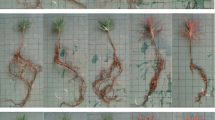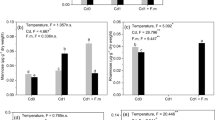Abstract
We examined exudation of low molecular weight (LMW) organic compounds of ectomycorrhizal (ECM) and non-mycorrhizal (NM) seedlings in relation to metals. Scots pine seedlings, either colonized by one of six different ECM fungi or NM, were grown in Petri dishes containing glass beads and liquid growth medium and exposed to elevated concentrations of Pb, Cd and As. Exudation of LMW organic compounds (LMW organic acids (LMWOAs), amino acids and dissolved monosaccharides) and dissolved organic carbon (DOC) was determined qualitatively and quantitatively and exudation rates were calculated. Metals had a significant impact on exudation, especially of oxalate. For Pb and Cd treatments, exudation of oxalate and total LMWOAs generally increased by 15–45% compared to nutrient controls. Production of amino acids, dissolved monosaccharides and DOC was not significantly stimulated by exposure to metals; however, there were non-significant trends towards increased exudation. Finally, exudation generally increased in the presence of mycorrhizal seedlings compared to NM seedlings. The results suggest that ECM fungi may reduce the toxicity of metals to plants through significant increases in the production of organic chelators. Axenic conditions are required to assess the full potential for production of these molecules but their overall significance in soil ecosystems needs to be determined using additional experiments under more ecologically realistic conditions.


Similar content being viewed by others
References
Ahonen-Jonnarth U, Finlay RD (2001) Effects of elevated nickel and cadmium concentrations on growth and nutrient uptake of mycorrhizal and non-mycorrhizal Pinus sylvestris seedlings. Plant Soil 236:129–138
Ahonen-Jonnarth U, van Hees PAW, Lundström US, Finlay RD (2000) Organic acids produced by mycorrhizal Pinus sylvestris exposed to elevated aluminium and metal concentrations. New Phytol 146:557–567
Antkowiak R, Antkowiak WZ, Banczyk I, Mikolajczyk L (2003) A new phenolic metabolite, involutone, isolated from the mushroom Paxillus involutus. Can J Chem 81:118–124
Appuhn A, Joergensen RG, Raubuch M, Scheller E, Wilke B (2004) The automated determination of glucosamine, galactosamine, muramic acid and mannosamine in soil and root hydrolysates by HPLC. J Plant Nutr Soil Sci 167:17–21
Arvieu J-C, Leprince F, Plassard C (2003) Release of oxalate and protons by ectomycorrhizal fungi in response to P-deficiency and calcium carbonate in nutrient solution. Ann For Sci 60:815–821
Bellion M, Courbot M, Jacob C, Blaudez D, Chalot M (2006) Extracellular and cellular mechanisms sustaining metal tolerance in ectomycorrhizal fungi. FEMS Microbiol Lett 254:173–181
Besl H, Bresinsky A (1997) Chemosystematics of Suillaceae and Gomphidiaceae (suborder Suillaceae). Plant Syst Evol 206:223–242
Blaudez D, Jacob C, Turnau K, Colpaert JV, Ahonen-Jonnarth U, Finlay RD et al (2000) Differential responses of ectomycorrhizal fungi to metals in vitro. Mycol Res 104:1366–1371
Brunner I, Frey B (2000) Detection and localization of aluminium and heavy metals in ectomycorrhizal Norway spruce seedlings. Environ Pollut 108(2):121–128
Casarin V, Plassard C, Souche G, Arvieu J-C (2003) Quantification of oxalate ions and protons released by ectomycorrhizal fungi in rhizosphere soil. Agronomie 23:461–469
Courbot M, Diez L, Ruotolo R, Chalot M, Leroy P (2004) Cadmium-responsive thiols in the ectomycorrhizal fungus Paxillus involutus. Appl Environ Microbiol 70:7413–7417
Culbertson BJ, Furumo NC, Daniel SL (2007) Impact of nutritional supplements and monosaccharides on growth, oxalate accumulation, and culture pH by Sclerotinia sclerotiorum. FEMS Microbiol Lett 270:132–138
Dahlén J, Hagberg J, Karlsson S (2000) Analysis of low molecular weight organic acids in water with capillary zone electrophoresis employing indirect photometric detection. Fresenius J Anal Chem 336:488–493
Duddridge JA (1986) The development and ultrastructure of ectomycorrhizas 3. Compatible and incompatible interactions between Suillus grevillei Klotzsch Sing and 11 species of ectomycorrhizal hosts in vitro in the absence of exogenous carbohydrate. New Phytol 103:457–465
Ekblad A, Näsholm T (1996) Determination of chitin in fungi and mycorrhizal roots by an improved HPLC analysis of glucosamine. Plant Soil 178:29–35
Fomina MA, Alexander IJ, Colpaert JV, Gadd GM (2005) Solubilization of toxic metal minerals and metal tolerance of mycorrhizal fungi. Soil Biol Biochem 37:851–866
Frey B, Zierhold K, Brunner I (2000) Extracellular complexation of Cd in the Hartig net and cytosolic Zn sequestration in the fungal mantle of Picea abies–Hebeloma crustuliniforme ectomycorrhizas. Plant Cell Environ 23:1257–1265
Gadd GM (1993) Interactions of fungi with toxic metals, Transley review. New Phytol 124:25–60
Gadd GM (1999) Fungal production of citric and oxalic acid: importance in metal speciation physiology and biogeochemical processes. Adv Microb Physiol 41:47–91
Gadd GM (2004) Microbial influence on metal mobility and application for bioremediation. Geoderma 122:109–119
Gadd GM (2007) Geomycology: biogeochemical transformations of rocks, minerals, metals and radionuclides by fungi, bioweathering and bioremediation. Mycol Res 111:3–49
Hartley JW, Cairney G, Freestone P, Meharg AA (1999) The effects of multiple metal contaminations on ectomycorrhizal Scots pine (Pinus sylvestris) seedlings. Environ Pollut 106:413–424
Hartley-Whitaker J, Cairney JWG, Meharg AA (2000) Sensitivity to Cd or Zn of host and symbiont of ectomycorrhizal Pinus sylvestris L. (Scots pine) seedlings. Plant Soil 218:31–42
Jarosz-Wilkolazka A, Graz M (2006) Organic acids production by white root Basidiomycetes in the presence of metallic oxides. Can J Microbiol 52:779–785
Jentschke G, Godbold DL (2000) Metal toxicity and ectomycorrhizas. Physiol Plant 109:107–116
Jentschke G, Marschner P, Vodnik D (1998) Lead uptake by Picea abies seedlings: effects of nitrogen source and mycorrhizas. J Plant Physiol 153:97–104
Jentschke G, Winter S, Godbold DL (1999) Ectomycorrhizas and cadmium toxicity in Norway spruce seedlings. Tree Physiol 19:23–30
Jones DL (1998) Organic acids in the rhizosphere—a critical review. Plant Soil 00:1–21
Jones DL, Darrah PR (1994) Role of root derived organic acids in the mobilization of simple C substrates. Plant Soil 166:247–257
Kim CG, Power SA, Bell JNB (2003) Effects of cadmium on growth and glucose utilization of ectomycorrhizal fungi in vitro. Mycorrhiza 13:223–226
Kim CG, Power SA, Bell JNB (2004) Response of Pinus sylvestris seedlings to cadmium and mycorrhizal colonization. Water Air Soil Pollut 155:189–203
Leyval C, Turnau K, Haselwandter K (1997) Effect of heavy metal pollution on mycorrhizal colonization and function: physiological, ecological and applied aspects. Mycorrhiza 7:139–153
Marschner P, Klam A, Jentschke G, Godbold DL (1998) Cation exchange capacity and lead sorption in ectomycorrhizal fungi. Plant Soil 205:93–98
Marschner P, Klam A, Jentschke G, Godbold DL (1999) Aluminium and lead tolerance in ectomycorrhizal fungi. J Plant Nutr Soil Sci 162:281–286
Marx DH (1969) The influence of ectotrophic ectomycorrhizal fungi on the resistance of pine roots to pathogen infections. I. Antagonism of mycorrhizal fungi to root pathogenic fungi and soil bacteria. Phytopathology 59:153–163
McCune B, Mefford MJ (1999) Multivariate analysis of ecological data. MjM Software, Gleneden Beach
Meharg AA (2003) The mechanistic basis of interactions between mycorrhizal associations and toxic metal cations. Mycol Res 107:1253–1265
Myklestad SM, Skånoy E, Hestmann S (1997) A sensitive and rapid method for analysis of dissolved mono- and polysaccharides in seawater. Mar Chem 1:279–286
Näsholm T, Sandberg G, Ericsson A (1987) Quantitative analysis of amino acids in conifer tissues by high-performance liquid chromatography and fluorescence detection of their 9-fluorenylmethyl chloroformate derivatives. J Chromatogr A 396:225–236
Ott T, Fritz E, Polle A, Schützendübel A (2002) Characterization of antioxidative systems in the ectomycorrhiza-building basidiomycete Paxillus involutus (Bartsch) Fr. and its reaction to cadmium. FEMS Microbiol Ecol 42:359–366
Ryan PR, Delhaize E, Jones DL (2001) Function and mechanism of organic anion exudation from plant roots. Annu Rev Plant Physiol Plant Mol Biol 52:527–560
Schilling JS, Jellison J (2006) Metal accumulation without enhanced oxalate secretion in wood degraded by brown rot fungi. Appl Environ Microbiol 72:5662–5665
Schwarz EL, Roberts WL, Pasquali M (2005) Analysis of plasma amino acids by HPLC with photodiode array and fluorescence detection. Clin Chim Acta 354:83–90
Sharma HD, Reddy KR (2004) Geoenvironmental engineering—site remediation, waste containment and emerging waste management technologies. Wiley, Hoboken
Sharples JM, Meharg AA, Chambers SM, Cairney JWG (2000) Symbiotic solution to arsenic contamination. Nature 404:951–952
Smith SE, Read DJ (1997) Mycorrhizal symbiosis, 2nd edn. Academic, London
Sun Y-P, Unestam T, Lucas SD, Johanson KJ, Kenne L, Finlay RD (1999) Exudation-reabsorption in mycorrhizal fungi, the dynamic interface for interaction with soil and microorganisms. Mycorrhiza 9:137–144
van Hees PAW, Rosling A, Essén S, Godbold DL, Jones DL, Finlay RD (2006) Oxalate and ferricrocin exudation by the extramatrical mycelium of an ectomycorrhizal fungus in symbiosis with Pinus sylvestris. New Phytol 169:367–378
van Schöll L, Hoffland E, van Breemen N (2006) Organic anion exudation by ectomycorrhizal fungi and Pinus sylvestris in response to nutrient deficiencies. New Phytol 170:153–163
Wallander H (2000) Use of strontium isotopes and foliar K content to estimate weathering of biotitic induced by pine seedlings colonized by ectomycorrhizal fungi from two different soils. Plant Soil 222:215–229
Zhu X, Cai J, Yang J, Su Q (2005) Determination of glucosamine in impure chitin samples by high-performance liquid chromatography. Carbohydr Res 340:1732–1738
Acknowledgements
We would like to thank Cajsa Nygren at the Department of Forest Mycology and Pathology, SLU, Uppsala for assisting with the fungal culture isolate numbers and sequences. We also thank the Swedish Research Council for Environment, Agricultural Sciences and Spatial Planning (FORMAS) for financial support.
Author information
Authors and Affiliations
Corresponding author
Additional information
Responsible Editor: Ellis Hoffland.
Rights and permissions
About this article
Cite this article
Johansson, E.M., Fransson, P.M.A., Finlay, R.D. et al. Quantitative analysis of root and ectomycorrhizal exudates as a response to Pb, Cd and As stress. Plant Soil 313, 39–54 (2008). https://doi.org/10.1007/s11104-008-9678-1
Received:
Accepted:
Published:
Issue Date:
DOI: https://doi.org/10.1007/s11104-008-9678-1




